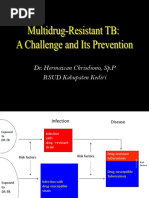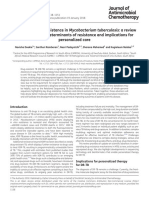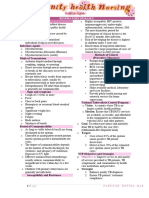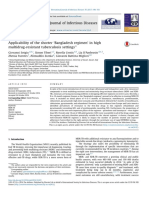Lecture MDR TB
Lecture MDR TB
Uploaded by
Roy Anthony CenizaCopyright:
Available Formats
Lecture MDR TB
Lecture MDR TB
Uploaded by
Roy Anthony CenizaOriginal Title
Copyright
Available Formats
Share this document
Did you find this document useful?
Is this content inappropriate?
Copyright:
Available Formats
Lecture MDR TB
Lecture MDR TB
Uploaded by
Roy Anthony CenizaCopyright:
Available Formats
cHRYSós 2 0 2 3
MDR-TB
Dr. nilyn OLIVA-YGNACIO
B3m2
Lecture
OBJECTIVES:
- Define and classify drug resistant TB
- Review updates on the incidence of MDR-TB
- Discuss the diagnostic flow of MDR-TB
- Identify laboratory tools necessary in this disease
- Discuss the treatment regimen of MDR-TB
- Emphasize on the importance of monitoring treatment, evaluation,
and prevention in MDR-TB
GOAL OF TREATMENT:
- Cure
- Minimizing transmission
PATTERNS OF RESISTANCE:
Multidrug resistance (MDR)
- Resistance to at least both isoniazid and rifampicin
Tuberculosis is the top infectious killer in the world:
Extensive drug resistance (XDR) - In 2019, 1.4 million** people died from tb
- Any fluoroquinolone - Including 208,000 people with HIV
- And at least one of three second-line injectable drugs (capreomycin, - TB is the leading killer of people with HIV and a major cause of
kanamycin and amikacin) deaths related to antimicrobial resistance
**The 95% uncertainty intervals are 1.1-1.3 million for TB deaths and 177,000
Pre-XDR TB to 242,000 for TB/HIV deaths
- Resistance to either 1 but not both classes of drugs
Drug-resistant tuberculosis remains a public health crisis:
- In 2019, about 0.5 million people fell ill with drug-resistant TB*
DIAGNOSIS - Only 38% people accessed the treatment
- Of those treated, only 57% were treated successfully
**The 95% uncertainty interval for the incidence of rifampin-resistant TB is
400,000 to 535,000. About 78% of these cases had multi-drug resistant TB
More people reached with quality TB care:
- In 2019, an estimated 10 million people fell ill with TB**
- 7.1 million people reported to have access to TB care up from 6.4
million in 2017
- =2.9million were undiagnosed or not reported
- Better reporting, diagnosis and access to care will close this gap
**The 95% uncertainty interval for TB incidence is 8.9-11.0 million
- Therefore, appropriate treatment with a combination of several
quality-assured TB medicines dramatically diminishes the risk of
selection of resistant strains.
- This is the rationale for using a combination of quality-assured
medicines when treating TB, while ensuring good adherence
PRIMARY DRUG RESISTANCE
- Primary or initial drug resistance means that a person has been
infected with a drug-resistant TB strain
- Transmission of drug-resistant TB occurs exactly in the same way as
transmission of drug susceptible TB
The two strongest risk factors for XDR-TB are:
1. Failure of an MDR-TB treatment regimen, which contains second-line
drugs including an injectable agent and a fluoroquinolone; and
2. Close contact with an individual with documented XDR-TB or with an
individual for whom treatment with a regimen including 2nd-line
drugs is failing or has failed
cHRYSós 2 0 2 3
MDR-TB
Dr. nilyn OLIVA-YGNACIO
B3m2
Lecture
TREATMENT
DIAGNOSTICS:
- Definitive diagnosis of drug-resistant TB requires that
Mycobacterium tuberculosis bacteria be detected and resistance to
anti-TB drugs determined.
o By isolating the bacteria
o By culture, identifying it as belonging to the M.
tuberculosis complex (MTBc), and
o Conducting drug susceptibility testing (DST) using solid
or liquid media or
o By performing a WHO endorsed molecular test to detect
TB DNA and mutations associated with resistance
Drug susceptibility testing:
- Phenotypic
- Genomic
First-line DST
- Most reliable for rifampicin and isoniazid
- Less reliable and reproducible for streptomycin, ethambutol and
pyrazinamide (pyrazinamide testing can only be performed on liquid
media after appropriate pH adjustment)
Second-line DST:
- Has good reliability and reproducibility for 2nd line injectable drugs
(amikacin, kanamycin, capreomycin) and fluoroquinolones
- Data on the reproducibility and reliability of DST for the other 2nd
line drugs are limited, and for several of them methods have not
been established or standardized;
- Data correlating DST results to the clinical outcome are still
insufficient
Ethionamide – has more side effects
Macrolide – did not make any difference in the treatment
cHRYSós 2 0 2 3
MDR-TB
Dr. nilyn OLIVA-YGNACIO
B3m2
Lecture
DURATION OF TREATMENT: Summary:
Intensive phase: - Prevention is better than cure
- Benefits of 5 to 7 months of treatment after conversion were more - Early diagnosis is always the key
pronounced
Continuation phase:
- MDR-TB only - total treatment duration of at least 15 and up to 21
months after culture conversion
- Pre-XDR TB and XDR-TB: total treatment duration of between 15 and
24 months after culture conversion
Correlate clinically:
- Time to conversion was inversely related to duration of treatment
after conversion
MONITORING TREATMENT
Assessment of patients when treatment failure is suspected:
- The treatment card should be reviewed to confirm that the patient
has fully adhered to treatment
- Look for undetected comorbidities
- The bacteriological data should be reviewed
- Review the DST
- Review treatment regimen
INFECTION CONTROL
MANAGEMENT OF CONTACTS (CONTACT TRACING)
Symptomatic adult contacts:
- An evaluation by a physician, including history and physical
examination
- A chest radiograph examination
- Sputum investigations (ideally a rapid diagnostic method such as
Xpert MTB/RIF, or if not available)
- Sputum smear microscopy, culture and drug susceptibility testing
(DST) and
- HIV testing (in areas of high HIV prevalence, or if anyone in the
household is known to be HIV positive)
Symptomatic child contact:
- An evaluation by a physician, including history and physical
examination
- A chest radiograph examination
- Tuberculin skin testing with purified protein derivative
- Sputum investigations (ideally a rapid diagnostic method such as
Xpert MTB/RIF, or if not available,
- Sputum smear microscopy, culture and DST); and
- HIV testing (in areas of high HIV prevalence, or if either parent is
known to be HIV-positive)
You might also like
- 2016 Ap English Language and Composition Course SyllabusDocument3 pages2016 Ap English Language and Composition Course Syllabusapi-344115469No ratings yet
- Ginsberg and Spigelman Nat Med 2007Document5 pagesGinsberg and Spigelman Nat Med 2007hst939No ratings yet
- Dr. Hermawan Chrisdiono, SP.P RSUD Kabupaten KediriDocument48 pagesDr. Hermawan Chrisdiono, SP.P RSUD Kabupaten KediribotolkecapNo ratings yet
- Journal BeijingDocument8 pagesJournal Beijinganon_134225730No ratings yet
- DKX 506Document14 pagesDKX 506د. محمد سند راشد الحصينيNo ratings yet
- Drug Resistant TuberculosisDocument16 pagesDrug Resistant TuberculosisFelicia ThevanNo ratings yet
- TheUnion DR TB GuideDocument2 pagesTheUnion DR TB GuideDhani KurniawanNo ratings yet
- Mandell, Douglas, and Bennett's Principles and Practice of Infectious DiseasesDocument47 pagesMandell, Douglas, and Bennett's Principles and Practice of Infectious Diseaseshnj43047No ratings yet
- Multi-Drug Resistance in Mycobacterium Tuberculosis.Document30 pagesMulti-Drug Resistance in Mycobacterium Tuberculosis.zakirullahNo ratings yet
- Adverse Drug Reactions and Outcome Analysis of MDR TB Patients On Dots Plus RegimenDocument5 pagesAdverse Drug Reactions and Outcome Analysis of MDR TB Patients On Dots Plus RegimenkopaljsNo ratings yet
- 2019 The Use of Colistin for the Treatment of Multidrug-resistant Gram-negative Infections in Neonates and Infants A Review of the LiteratureDocument6 pages2019 The Use of Colistin for the Treatment of Multidrug-resistant Gram-negative Infections in Neonates and Infants A Review of the Literaturehamid rahimiNo ratings yet
- Bagaimana Cara Merancang Regimen Induvidual Pada FinalDocument41 pagesBagaimana Cara Merancang Regimen Induvidual Pada FinaldarmaNo ratings yet
- Midterm CHN Reviewer 2023Document27 pagesMidterm CHN Reviewer 2023Reyzel PahunaoNo ratings yet
- BY Dr. Tahmina AzharDocument71 pagesBY Dr. Tahmina Azharscribdnotes123No ratings yet
- CTS 2 80Document5 pagesCTS 2 80Rizky AmeliaNo ratings yet
- Putra, 050 - 2901 - Nur Chayati - GalleyDocument10 pagesPutra, 050 - 2901 - Nur Chayati - GalleyHarumiNo ratings yet
- DR José Caminero of The Union On Challenge of anti-TB Resistance in Context of SDGsDocument29 pagesDR José Caminero of The Union On Challenge of anti-TB Resistance in Context of SDGsbobbyramakantNo ratings yet
- Tuberculosis Control in RI: Maintaining Control Efforts in The Context of Declining Incidence and Funding For Tuberculosis ProgramsDocument5 pagesTuberculosis Control in RI: Maintaining Control Efforts in The Context of Declining Incidence and Funding For Tuberculosis ProgramsIra TryNo ratings yet
- What Is Multidrug-Resistant Tuberculosis (MDR-TB) ?Document63 pagesWhat Is Multidrug-Resistant Tuberculosis (MDR-TB) ?Birhanu AbebeNo ratings yet
- Diagnosis and Treatment of Drug-Resistant Tuberculosis-Hermanto QuedarusmanDocument20 pagesDiagnosis and Treatment of Drug-Resistant Tuberculosis-Hermanto QuedarusmanHermanto QuedarusmanNo ratings yet
- NCM 104 Finals Module 1Document15 pagesNCM 104 Finals Module 1Keana BaganoNo ratings yet
- Anti-Infectives Drug Advisory Committee MeetingDocument253 pagesAnti-Infectives Drug Advisory Committee MeetingbellamajNo ratings yet
- Journal of TBCDocument14 pagesJournal of TBCaura tmc 10No ratings yet
- Tratamiento de Tuberculosis LatenteDocument13 pagesTratamiento de Tuberculosis LatenteCarmen MolinaNo ratings yet
- Evaluating Bedaquiline As A Treatment Option For Multidrug-Resistant TuberculosisDocument8 pagesEvaluating Bedaquiline As A Treatment Option For Multidrug-Resistant Tuberculosisa29921No ratings yet
- Paper TB MDRDocument8 pagesPaper TB MDREra SulistiyaNo ratings yet
- Drug Resistance TBDocument2 pagesDrug Resistance TBnishajadon789No ratings yet
- 10 1080@1744666X 2019 1705785Document85 pages10 1080@1744666X 2019 1705785infectologia larazaNo ratings yet
- 1 PBDocument10 pages1 PBNisha VertianaNo ratings yet
- TRT2017 4920209Document12 pagesTRT2017 4920209ADVOCATE ASHUTOSH SHARMANo ratings yet
- 6 COMMUNICABLE DISEASES Nies PDocument14 pages6 COMMUNICABLE DISEASES Nies PMontero, Ma. Cecilia - BSN 3-BNo ratings yet
- JurnalDocument4 pagesJurnalAnonymous pfHZusnNo ratings yet
- Mycobacterium Tuberculosis in Central Ethiopia: Drug Sensitivity Patterns and Association With GenotypeDocument6 pagesMycobacterium Tuberculosis in Central Ethiopia: Drug Sensitivity Patterns and Association With GenotypeMenda JangWooyoung SooyoungsterNo ratings yet
- Impact of Bedaquiline Regimen On The Treatment Success Rates of Multidrug Resistant Tuberculosis Patients in EgyptDocument9 pagesImpact of Bedaquiline Regimen On The Treatment Success Rates of Multidrug Resistant Tuberculosis Patients in Egyptaura tmc 10No ratings yet
- Public Health Aspects of TBDocument53 pagesPublic Health Aspects of TBmaskericon ChivesNo ratings yet
- Management of Complex Tuberculosis Cases A Focus On Drug ResistantDocument20 pagesManagement of Complex Tuberculosis Cases A Focus On Drug ResistantJorge GonzalesNo ratings yet
- Definisi TB MDRDocument15 pagesDefinisi TB MDRhneyxelowNo ratings yet
- Short MDR Regimen Factsheet PDFDocument2 pagesShort MDR Regimen Factsheet PDFnasyiahNo ratings yet
- NTEPDocument70 pagesNTEPG K swethaNo ratings yet
- International Journal of Infectious DiseasesDocument4 pagesInternational Journal of Infectious DiseasesPedro MalikNo ratings yet
- Al‑Mutairi 2021Document9 pagesAl‑Mutairi 2021mahamedoumaraNo ratings yet
- Classification of Drug-Resistant Tuberculosis in An Epidemic AreaDocument4 pagesClassification of Drug-Resistant Tuberculosis in An Epidemic AreaTika Dwi TamaNo ratings yet
- Low-Dose Linezolid For Treatment of Patients With Multidrug-Resistant Tuberculosis 2022Document10 pagesLow-Dose Linezolid For Treatment of Patients With Multidrug-Resistant Tuberculosis 2022awaluddin andyNo ratings yet
- MDR TBDocument8 pagesMDR TBMahira Bayu AdiftaNo ratings yet
- Factor Associated With TBCDocument8 pagesFactor Associated With TBCaura tmc 10No ratings yet
- MDR TB FactsheetDocument2 pagesMDR TB FactsheetfaradillaNo ratings yet
- Journal Pone 0245687Document13 pagesJournal Pone 0245687فرجني موغNo ratings yet
- Otu 2018Document13 pagesOtu 2018Carlos MejiaNo ratings yet
- 38 Antimycobacter 2015 Mandell Douglas and Bennett S Principles and PracDocument20 pages38 Antimycobacter 2015 Mandell Douglas and Bennett S Principles and PracHelen DyNo ratings yet
- Mayoclinproc 86 4 014 PDFDocument14 pagesMayoclinproc 86 4 014 PDFAnisoara AvonNo ratings yet
- 174 - LeprosyDocument12 pages174 - Leprosy4g8psyr2qfNo ratings yet
- Tuberculosis: Nurul Najwa Binti Zulkifli (131855)Document18 pagesTuberculosis: Nurul Najwa Binti Zulkifli (131855)Nurul NajwaNo ratings yet
- Jurnal Korea Pemilihan Regimen Long Dari Pada Regimen ShortDocument9 pagesJurnal Korea Pemilihan Regimen Long Dari Pada Regimen Shorthasan andrianNo ratings yet
- Alrajhi 2002Document6 pagesAlrajhi 2002mahamedoumaraNo ratings yet
- Minireview: New Drugs Against Tuberculosis: Problems, Progress, and Evaluation of Agents in Clinical DevelopmentDocument14 pagesMinireview: New Drugs Against Tuberculosis: Problems, Progress, and Evaluation of Agents in Clinical DevelopmentcgandarelaNo ratings yet
- 5.5 XDR TB PDFDocument4 pages5.5 XDR TB PDFmustafaNo ratings yet
- Singh., 2020. Mekanisme Resistensi ObatDocument21 pagesSingh., 2020. Mekanisme Resistensi Obathasan andrianNo ratings yet
- Paradigma Pemeriksaan TBDocument40 pagesParadigma Pemeriksaan TBTengku AdriansyahNo ratings yet
- Current treatment of nosocomial pneumonia and ventilator-associated pneumoniaDocument5 pagesCurrent treatment of nosocomial pneumonia and ventilator-associated pneumoniaanonimovanderwallsNo ratings yet
- COVID-19 Mortality Review in Malaysia & Updates on Clinical Management of COVID-19From EverandCOVID-19 Mortality Review in Malaysia & Updates on Clinical Management of COVID-19No ratings yet
- Long-Hauler: Manual for Long-Covid and Post-Vaccine SyndromeFrom EverandLong-Hauler: Manual for Long-Covid and Post-Vaccine SyndromeNo ratings yet
- Lecture PCAPDocument3 pagesLecture PCAPRoy Anthony CenizaNo ratings yet
- Lecture Extrapulmonary TBDocument6 pagesLecture Extrapulmonary TBRoy Anthony CenizaNo ratings yet
- Lecture TB TREATMENTDocument5 pagesLecture TB TREATMENTRoy Anthony CenizaNo ratings yet
- Ambivalence & UncertaintyDocument2 pagesAmbivalence & UncertaintyRoy Anthony CenizaNo ratings yet
- Parasitology Module 3 Part 1Document72 pagesParasitology Module 3 Part 1Roy Anthony CenizaNo ratings yet
- Algebra and LifeDocument1 pageAlgebra and LifeRoy Anthony CenizaNo ratings yet
- Home Reading ReportDocument8 pagesHome Reading ReportRoy Anthony Ceniza100% (4)
- CC 1 - Specimen CollectionDocument6 pagesCC 1 - Specimen CollectionRoy Anthony CenizaNo ratings yet
- Chop Suey: Learning Team 2Document4 pagesChop Suey: Learning Team 2Roy Anthony CenizaNo ratings yet
- Mintz, Sidney "The So-Called World-System" (1977)Document18 pagesMintz, Sidney "The So-Called World-System" (1977)krista_lillemetsNo ratings yet
- Constantino Vs MendezDocument1 pageConstantino Vs MendezJo JosonNo ratings yet
- Bahrain (Guide)Document8 pagesBahrain (Guide)saquib usmaniNo ratings yet
- CommunicationDocument38 pagesCommunicationNamrata PathakNo ratings yet
- Library of Broken Worlds ExcerptDocument27 pagesLibrary of Broken Worlds ExcerptI Read YANo ratings yet
- The Educational Attainment of The Household Population (Results From The 2010 Census)Document9 pagesThe Educational Attainment of The Household Population (Results From The 2010 Census)Garyluv MuyaNo ratings yet
- Mamalintao, Jahnuel S.-Module 1 Activity 1Document3 pagesMamalintao, Jahnuel S.-Module 1 Activity 1Jahnuel MamalintaoNo ratings yet
- Wreck of Hesperus AnalysisDocument9 pagesWreck of Hesperus Analysisapi-257262131No ratings yet
- Pembaharuan Data Gelar, NIP, Golongan Dan Jabatan Fungsional Dosen FP UNILA-Genap 2324Document30 pagesPembaharuan Data Gelar, NIP, Golongan Dan Jabatan Fungsional Dosen FP UNILA-Genap 2324Dyah KNo ratings yet
- G3 Module 7 - Customer RelationsDocument10 pagesG3 Module 7 - Customer RelationsEthan BlackNo ratings yet
- 04 - Project Cost ManagementDocument20 pages04 - Project Cost Managementndizz100% (1)
- Pelvic ExamDocument5 pagesPelvic ExamKate RamosNo ratings yet
- 104 Supreme Court Reports Annotated: Quinagoran vs. Court of AppealsDocument12 pages104 Supreme Court Reports Annotated: Quinagoran vs. Court of AppealsFairyssa Bianca SagotNo ratings yet
- Mark's Grade 7 sp1 Holiday Assignment Term 1 - 2020 PDFDocument4 pagesMark's Grade 7 sp1 Holiday Assignment Term 1 - 2020 PDF360MaRko oo.No ratings yet
- Dialogue 1Document2 pagesDialogue 1sri yulianaNo ratings yet
- 40 Hadith On The Qur AnDocument13 pages40 Hadith On The Qur AnRadia Rasheed-Ben FayedNo ratings yet
- Starkville Dispatch Eedition 9-25-19Document16 pagesStarkville Dispatch Eedition 9-25-19The DispatchNo ratings yet
- Ramayana - Environment PreservationDocument5 pagesRamayana - Environment PreservationMoorthy Iyer100% (1)
- Sorting and Its TypesDocument26 pagesSorting and Its Typesnofiya yousufNo ratings yet
- Customer Relationship AssignmentDocument14 pagesCustomer Relationship AssignmentKomal KatariaNo ratings yet
- Way of The Saffron Cloud.: Kulwant SinghDocument84 pagesWay of The Saffron Cloud.: Kulwant Singhwww.khojee.wordpress.com0% (1)
- Gorkha Brewery - ChapterDocument35 pagesGorkha Brewery - ChapterMADHU KHANALNo ratings yet
- Sam Sokol: Conference Members Voted To Reject J-Street After Critics Accused The Group of Being Anti-IsraelDocument4 pagesSam Sokol: Conference Members Voted To Reject J-Street After Critics Accused The Group of Being Anti-Israelkwintencirkel3715No ratings yet
- ArticleDocument13 pagesArticlegetnet teferaNo ratings yet
- ScorpioDocument7 pagesScorpioAzothmagnumNo ratings yet
- Exercise 1: Write The Correct Answers Based On The Picture.: February ExercisesDocument5 pagesExercise 1: Write The Correct Answers Based On The Picture.: February Exerciseslim jeeyinNo ratings yet
- Kolb Learning StylesDocument7 pagesKolb Learning StylesGaurav Waghmare0% (1)
- Webercise 1Document2 pagesWebercise 1api-398069645No ratings yet
- Set 6Document24 pagesSet 6Soumava BasuNo ratings yet


































































































